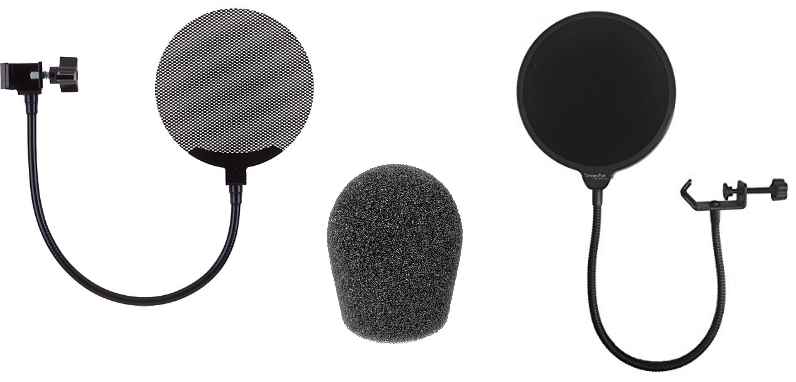
To most voice actors, pop filters are one of the most essential tools in their studio collection that they would nearly never work without one. It speaks about why most photographs of a voice-over talent at a microphone in a studio session have that big black circle that stands between the mic and the talent.
But what is a pop filter, and why does it demand to be used?
What is a pop filter?
A pop filter, also known as a pop shield or pop screen, is a circle of nylon mesh or a thin metal that you attach to your microphone stand, positioned between the microphone and the sound source. The pop filter was invented for the existence of “plosives” — explosive consonants heard from words that start with “p” or “b” which is normally part of our natural speech.
They are also sometimes mistakenly referred to as a microphone windscreen or windshield–a similar device that’s primarily used by location sound recordists, for reducing noise from the wind when recording outside.
But a windscreen is far from being an alternative to a pop filter. Why? Because it’s made specifically to deflect breezes when being used outside at concerts, interviews, or film shoots, and not for a full-on plosive absorption. Furthermore, the thickness of foam invariably absorbs some high frequencies, causing the sound to become noticeably duller than it should be.
Why and how do popping sounds occur?
Dead sure, you have tried distinguishing the sound of your speech when spoken normally and on a microphone. Noticed that the microphone speech is ruined by loud popping and banging noises?
These pops and thumps are called ‘plosive’ sounds. Words that start with these letters “p” or “b” produce a burst of air which your microphone’s diaphragm will pick up, causing your input level to spike.
Similar to when you try to utter words starting with “p” or “b” in front of a lighted candle, you would see the flame flicker. That is because we let out more air when making these sounds. Oppositely, if you vocalize a long ‘ahh’ sound, the candle will barely flicker at all, because you’re mainly just producing sound vibrations with your vocal cords and expelling very little air.
The problem worsens if the mouth is very close to the microphone. The plosive air blast is obviously strongest close to the mouth, and when it slams into the microphone diaphragm, it produces a very large asymmetrical output signal. This may be so large that it can saturate the microphone’s output transformer (if present) or overload the mic preamp, making the sound even worse. Engaging the low-cut filter on the mic (ideally) or preamp may ease the overloading problem, but the basic cause of the popping will remain.
Uses and advantages of pop filters
There’s nothing magic about pop filters; in fact, you can improvise your own pop filter using ordinary stocking nylon if your creativity strikes and if your time permits you. Here’s a tutorial video on DIY pop filters:
However, despite its simplicity, the humble pop filter provides benefits that make it an extremely useful recording tool. Whether you’re a voice actor, singer, musician, or studio engineer, a pop filter is equally useful to just about anyone who records speech or vocals.
Here are the main uses of pop filters:
1. Eliminates plosive sounds
Pop filters are invented to get rid of plosive sounds like Ps and Bs that ruin our recording quality and can minimize the sibilance, the hissing noise from S sounds.
As the burst of air moves towards the microphone, the fabric fine mesh acts as a shield that breaks it up, having the air molecules dispersed. As a result, the burst of air loses its impact on the microphone’s diaphragm.
For extra, many pop filters are designed with two layers of fabric placed a small distance from one another. This provides a second layer of protection–anything that breaches the first layer is caught by the second. It’s important to note that you need to leave a few inches of space between the pop shield and your microphone, as there needs to be a mass of air in between to be fully effective.
If you refuse to use a pop filter when doing your recordings, your voice over outputs are likely to have something that makes you want to retake your script.
2. Microphone protection
When you talk to a microphone, some combination of moisture, saliva, and dust being forced into the microphone capsule is inevitable. The components inside a microphone are very delicate, and if you’ve spent good money on a high-quality microphone, the last thing you want is damage from moisture settling in the capsule. Over time, this can even lead to mold growth–unpleasant, unhygienic, and damaging to your cherished mic.
With pop filters, your microphone is instantly protected from all this dirt. Don’t worry about your filters, as they are easy to clean and there are pop shields which filters are replaceable.
Voice Actor’s guide in choosing a pop filter
We have covered the reasons pop filters are necessary for doing your voice overs. Is a continuation focusing on the types and what to look for in a pop filter to tailor what’s best for your voice and your microphone.
Types of pop filter
There are various types of pop filters available on the market: ones made of nylon mesh and those of thin metal.
Nylon Mesh pop filters
The nylon mesh pop filters are the original version of the tool. They’ve been used for decades as the standard plosive shield in the music and voice over industry. This pop filter is not bad for beginners as they are inexpensive but works just fine, your plosives are reduced.
However, some engineers claim that high frequencies of the voice are often removed too. Another downside is that nylon is delicate and can be easily damaged.
Metallic Mesh / Metal pop Filters
To address the cons of nylon mesh, metal pop filters are invented around a few decades ago. They are more durable than nylon mesh. Designed with wider holes, they have less effect on taking away the high frequencies and are easier to clean.
The only downside is that the metal sheet is thin, so it can be easily bent if clumsy and over time, metal filters can rust and develop a slight whistling sound.
Things to note when choosing a pop filter
size
The size of your pop filter should align with the size of your microphone. You want a diameter that suits both your microphone and your style of recording. If you move around a lot when you are recording, a pop filter with a larger diameter may be best suited for you.
Shape
There are different shapes of pop filters available on the market. Flat filets are more cost-effective, but require you to speak more directly into the center. Curved filters provide you more range and allow you to move whenever while you are recording since they work from any angle.
Mounts
The mount of the filter is another important factor to consider. Most pop filters come with a gooseneck mount that screws into the filter frame and the clamp. You want to make sure that the gooseneck neck is long enough so that you can attach the filter in front of the microphone correctly.
Compatibility with your voice and microphone
Just like the compatibility of a microphone to your voice type, a pop filter works best depending on your voice and microphone too. The most expensive one does not mean to work like a magic to bring out the best of your voice over.
When deciding to purchase a pop filter, just test out as many as possible to ensure that it fits your voice and your microphone, giving you the best result.
Durability
Studio engineers often complain about the durability of a pop filter. The arm itself on a pop filter can sag over time, and the filter refuses to stay in place for a long time. Not only is that a minor but frustrating problem, it’s also using up valuable studio time having to repetitively fix it.
Like all things studio related, it’s worth spending that bit extra on a quality pop shield–one that’s built to last, is suitable for multiple occasions, and performs exactly as you need it to.
It also helps if the clamp is strong, and a squeezable clamp is preferable to a screw-based fixing, as those take more time to set up, will often leave marks (or even damage) to your mic stands, can be fiddly, and will often weaken. Put short, look for a quality product that suits your needs, and won’t need replacing.
Simplicity
You know a pop filter is also the one if you can set up quickly and painlessly, so that once it’s in place, you can just forget about it, and get on with recording that perfect vocal take. Too, a pop filter is a simple tool that is supposed to polish your recording quality, and not cause you extra complexity.
Knowing how to choose a good pop filter is easy. You just need to make sure that the focus of your recordings will be the excellent sound quality and that any unwanted noises will be filtered out and not picked up by your microphone.





